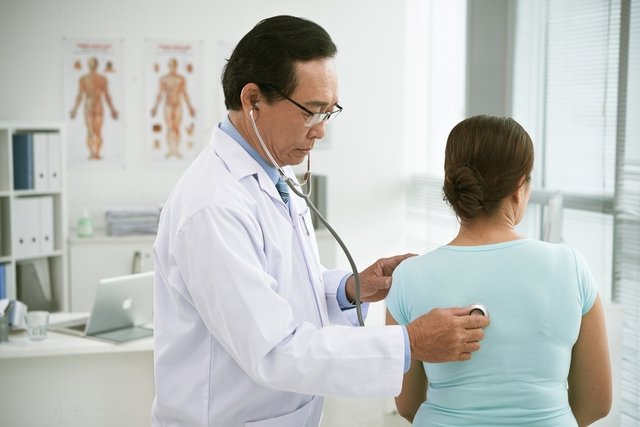The main symptoms of pneumonia are high fever, tiredness, dry cough or phlegm, mental confusion, chest pain and shortness of breath. However, in some cases, pneumonia symptoms can be so mild that they end up being confused with other situations, such as allergies, flu or colds.
The symptoms of pneumonia vary according to the type of microorganism that causes the disease, such as viruses, fungi or bacteria, the person’s age and health status, and, therefore, it is important to consult a general practitioner, pulmonologist or pediatrician, in the case of children, so that the most appropriate treatment can be indicated.
Treatment for pneumonia can vary according to the severity of symptoms and the cause of the infection, but generally involves medications such as antibiotics or antivirals and, in more severe cases, the use of oxygen and respiratory physiotherapy.

Pneumonia symptoms
The main symptoms of pneumonia are:
- Difficulty breathing or shortness of breath;
- Breathing faster than normal;
- Fever above 38ºC;
- Dry cough;
- Cough with greenish or bloody phlegm;
- Chest pain;
- Night sweats;
- Frequent tiredness or muscle pain;
- Constant headache.
Pneumonia symptoms can be severe, or milder, as in the case of silent pneumonia. See also the symptoms of silent pneumonia.
In all cases of suspected pneumonia, it is important to consult a general practitioner, pediatrician or pulmonologist for an evaluation and to initiate the most appropriate treatment.
Symptoms of pneumonia in babies and children
The main symptoms of pneumonia in babies and children include cough, fever, wheezing, vomiting, difficulty feeding, tiredness, weakness and rapid breathing. However, pneumonia in babies and children does not always cause many symptoms.
Additionally, symptoms often vary depending on age, the cause of the pneumonia, and the severity of the illness. Learn about other symptoms of pneumonia in babies.
Symptoms of pneumonia in adults and the elderly
The main symptoms of pneumonia in adults are:
- Fever;
- Chills;
- Dry cough or cough with greenish, yellowish or bloody phlegm;
- Shortness of breath or difficulty breathing;
- Rapid breathing;
- Chest pain;
- Loss of appetite;
- Headache;
- Tiredness;
- Weight loss.
However, older people tend to have milder symptoms and typically do not have a fever. Furthermore, older people may experience sudden changes in behavior, such as agitation or mental confusion, which could be a sign of an infection such as pneumonia.
Pneumonia Symptoms Online Test
If you think you may have pneumonia, select the symptoms you present in the test below to find out your risk:
If pneumonia is suspected, it is recommended to consult a clinician, pediatrician or pulmonologist for an evaluation.
When to make an appointment
It is recommended to make an appointment with a pulmonologist, general practitioner or pediatrician when there are symptoms that could be indicative of pneumonia.
The doctor may order additional tests, such as an X-ray, blood test, bronchoscopy or sputum test, to help with the diagnosis and, if necessary, indicate appropriate treatment. See how pneumonia is diagnosed.
Taking care of your health has never been easier!
Who is most at risk of getting pneumonia
People who are most at risk of getting pneumonia are:
- People over 65 years old and children under 2 years old;
- People undergoing chemotherapy treatment;
- People with autoimmune diseases, such as lupus, rheumatoid arthritis, and multiple sclerosis, and who are using medications to suppress the immune system
- People with neurological conditions that make swallowing difficult, such as Alzheimer’s, Parkinson’s disease and stroke;
- People with HIV/AIDS;
- People who smoke and consume alcoholic beverages;
- People with diseases that affect the lungs or heart, such as asthma, uncontrolled diabetes, cystic fibrosis and emphysema.
Furthermore, people who are hospitalized, who spend a lot of time lying down or who require breathing equipment are also at greater risk of acquiring pneumonia, because these situations favor the accumulation of mucus and microorganisms in the lungs.
How to confirm the diagnosis
The diagnosis of pneumonia is usually confirmed by a general practitioner, pediatrician or pulmonologist, who takes into account the symptoms presented and may indicate tests such as chest x-ray and testing for the influenza virus in respiratory secretions.
Although less used, computed tomography and chest ultrasound may also be indicated in some cases and, depending on the severity, blood tests such as blood count, blood culture, urea and creatinine levels may be necessary, especially when hospitalization is indicated. .
How the treatment is carried out
Pneumonia treatment generally lasts between 7 and 21 days, and varies according to the cause and severity of the disease, and the use of medications, such as antibiotics and antipyretics, and oxygen therapy, may be indicated. Additionally, chest physiotherapy may also be recommended to help thin secretions and strengthen the lungs. Learn about the different recommended treatments for pneumonia.
Some precautions can strengthen the immune system, helping to complement pneumonia treatment, such as drinking plenty of water, getting a good night’s sleep and maintaining a balanced diet.
See the video below for more details about the different types of treatment for pneumonia:

Sign up for our newsletter and stay up to date with exclusive news
that can transform your routine!
Warning: Undefined array key "title" in /home/storelat/public_html/wp-content/plugins/link-whisper-premium/templates/frontend/related-posts.php on line 12
Warning: Undefined array key "title_tag" in /home/storelat/public_html/wp-content/plugins/link-whisper-premium/templates/frontend/related-posts.php on line 13



